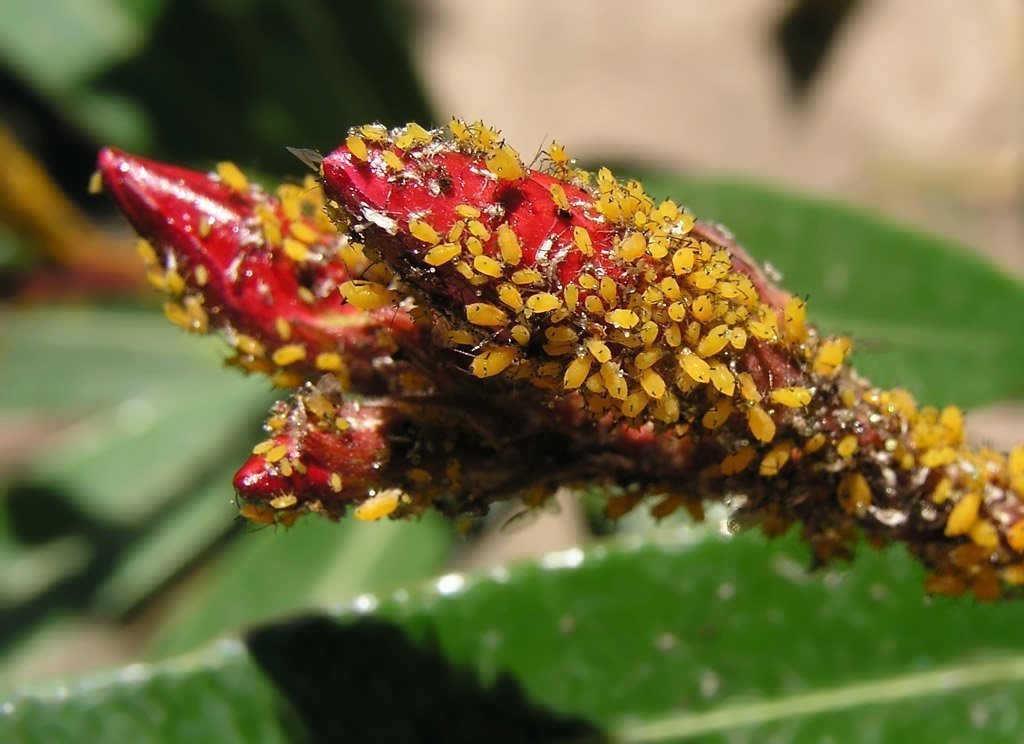Plant pest number 1: the aphid
 Aphids are among the most common animals that damage plants. After taking a break in winter, they appear more frequently in spring. The small proboscis of the aphids attack the plant cells of the young leaves directly.
Aphids are among the most common animals that damage plants. After taking a break in winter, they appear more frequently in spring. The small proboscis of the aphids attack the plant cells of the young leaves directly.
By doing so, they suck out the nutritious sugary plant sap and extremely weaken the plant and make it more susceptible to diseases.
Detect aphids
You can often recognize them by the so-called honeydew that runs over the leaves. Aphids can only use part of the plant sap. Most of them are eliminated again. This sticky coating on the plant is a reliable indicator of aphid infestation.
Dried up curled leaves or falling buds on the plant can also indicate aphids.
Fight aphids
If your beloved plant is infested with aphids, no need to panic! It does not have to be an expensive chemical agent from the garden center. We show you 3 home remedies against aphids that you probably already have at home.
1. Dishwashing liquid and soft soap:
Dissolve dish soap/soft soap in the water. Then spray the plant, being careful not to get the solution on the ground. You can then wipe off the aphid infestation with a cloth. Repeat several times.
2. Canola oil
For the water-oil emulsion, the mixing ratio is: 70% water and 30% oil. You can apply the emulsion to the plant parts with the spray bottle.
3. Nettle liquid manure
You need flowering nettles for the liquid manure. You should ferment one kilo of the herb in about 10 liters of water for one to two weeks. Then you always dilute one liter of the nettle liquid manure with ten liters of water. Spray your infested plant with it every two weeks.
Prevent aphids
Tip 1: Aphids don't like the smell of garlic at all. So you can easily bury a few toes deep in the potting soil.
Tip 2: Place a lavender plant or savory next to your other houseplants. The aphids don't like the essential oils of these plants at all.
Tip 3:Fertilization with synthetic fertilizers often leads to wrong fertilization (too much nitrogen in the soil). Therefore, avoid this and use biological means better.
Plant pest #2: scale insects
Scales infest both useful and ornamental plants and are therefore found outdoors, but also in your home. The female scale insects have a proboscis with which they suck up the shoots, petioles and leaves of a plant. This removes valuable nutrients from the plant.
Depending on the species, the scale insects can, in addition to sucking, also release poison into the plant, or like the aphids they produce honeydew. This in turn is an ideal breeding ground for certain types of fungi. This puts a double strain on the plant.
Detect scale insects
Unfortunately, an infestation with scale insects only becomes noticeable very late. Since the little animals initially live quite inconspicuously on the underside of the leaf and in the leaf axils. Therefore, it is difficult to recognize them at an early stage. If the damage is visible from the outside, then the infestation is usually far advanced.
Leaves lying on the ground, brown spots/humps on the leaves, unopened buds, fallen flowers are all indicators of a scale insect infestation.If that's the case, then you should do something urgently
Fight scale insects
1. Nettle
Use either 200 g fresh nettles or 20 g dried leaves. Crush them and pour cold water over them. You should then let the mixture steep for about eight hours.
Pour the mixture through a sieve to catch the leaves and spread the solution over the affected plant using a spray bottle.
2. Oregano
In addition to the nettle herb, oregano from the garden can also help. For the solution you have to pour 100 grams of fresh oregano, alternatively 10 grams of dried oregano, with one liter of boiling water. After about 15 minutes you can pour the brew through a sieve. However, you should always apply the brew diluted with water in a ratio of 3:1 to the plant using a spray bottle.
3. Garlic
You can either stick a clove of garlic in the ground, or make a garlic decoction, which is more effective. For the production you need 50 g fresh chopped garlic, which you pour over 1.5 L boiling water. You should let the brew stand for at least half an hour so that the active ingredients of the garlic can develop perfectly. Then you can put the cooled mixture, poured through a sieve, into a spray bottle and spray it on the affected parts of the plant.
Prevent scale insects
Especially in winter and spring you should check your plants regularly for an infestation. The condition of the plant determines whether or not the pests will make themselves at home on it. Make sure that your plant gets enough light even in winter and doesn't suffer too much from dry heating air.
In addition, strong chemical nitrogen fertilization has a negative effect on the health of your plant. Therefore: Stay away from chemical fertilizers that contain too much nitrogen!
Plant pest #3: mealybugs
In Central Europe, the citrus mealybug and the long-tailed mealybug are the most common. The females lay their eggs (up to 600) on the leaves or soil of the plant. After 10 days the time has usually come: the larvae hatch from their eggs and unfortunately spread rapidly.
Detect mealybugs
Actually, you can tell if there is a mealybug infestation: Small, white webs surround the little animals. . In addition, mealybugs, like aphids, secrete honeydew as a waste product. This sticky, sweet substance is highly attractive to sooty fungus. The leaves also often turn yellow and curl up until they fall off.
Fight mealybugs
Here we present three remedies against mealybugs. You will probably already find most of the home remedies at home. have.
1. Garlic
A proven remedy against mealybugs is the garlic decoction. To make this home remedy, you must first chop 50g of fresh garlic very finely. Then pour 1.5 L of boiling water over it.
Let the brew stand for about 30 minutes. Then you can pour it through a sieve. When the brew has cooled down, you can apply it to the infested plant using a spray bottle.
2. Soap solution
Dissolve 2 tablespoons of soft or curd soap in one liter of water. You can then dampen a rag with the solution and wipe the infested plant with it. Alternatively, you can put the solution in a spray bottle. Always make sure that the remedy does not spill on the soil in the pot.
3. Nettle Brew
For the brew, you should pour 10 L of boiling water over 1 kg of fresh nettles in a container.You should now let the covered container steep for three days (preferably stir once a day). Then you can pour the brew through a sieve, as with the horsetail herb, and pour it into a spray bottle with which you can spray the affected parts of the plant.
Prevent mealybugs
Tip 1: Dry air and a location that is too warm or too dark encourage infestation with mealybugs. So keep this in mind when choosing the location of your plant.
Tip 2: Always make sure your apartment is well ventilated and avoid dry heating air.
Tip 3: Always follow the instructions on the fertilizer exactly. Mealybugs feel very comfortable when the soil is over-fertilized with nitrogen.

.



















Leave a comment